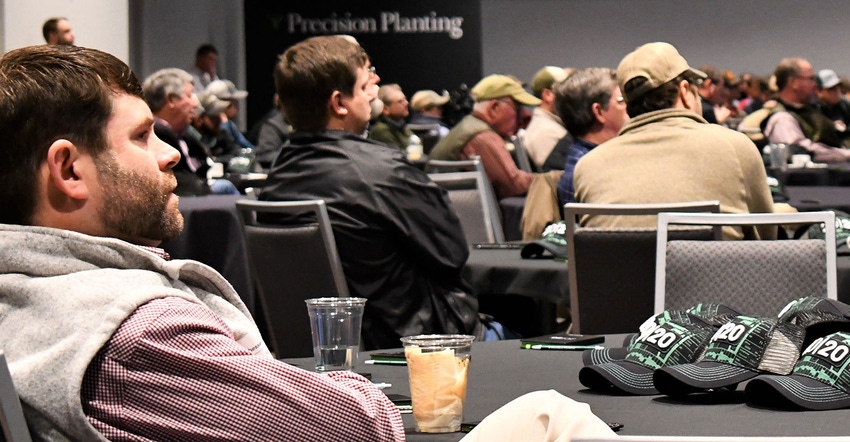
Three farm practices for better efficiency and higher yields may seem simple, but according to Jason Webster, commercial agronomist at Precision Planting, the right planting date, type of seed, and proper downforce are the top three things that could increase or decrease profitability.
Webster gave economic data taken from the Precision Technology Institute (PTI Farm) at the Precision Planting Winter Conference 2020 live simulcast in January in Starkville, Miss.
"I think profitability is on everybody's mind as we go into 2020, so I decided for this talk to take the trials from the PTI Farm that made the most money and cost us the most money and share information from those trials," Webster said.
Planting date
According to the data, planting corn in good conditions on the right date was the number one thing that provided either good yields or cost farmers.
"It was hard to plant last spring because every other day it was raining, and we thought a lot about planting by the calendar versus when things were fit," he said. "We were all looking at the calendar, and saying, 'It's getting too late. I have to go.' I was one of those people myself."
Webster said he, like many other farmers, started planting in wet, muddy conditions.
"I knew it was too wet," he said. "I knew conditions weren't right, but I watched as all my neighbors started to plant. Have you guys ever done that?
"I saw my neighbors planting, and I said, 'We're going to do planting date entries when we see folks trying to plant by the calendar versus when it is fit."
In Illinois, Webster said May 20 was the optimal time to plant corn since the ground was dry enough by that point.
"When we planted later, it didn't hurt us much in 2019," he said. "It was one of those growing seasons where later planting worked out best. It was high moisture corn, but the yields were average.
"Planting earlier in those tough conditions, we saw 57- to 67-bushel losses. You can put all the technology on a planter you want, but if you're planting in mud, it's not going to be a good situation. However, many of us were forced to do it with the weather last year."
Type of seed
The second thing that made or cost farmers the most money was the seed planted.
"We like to do a pre-stress seed test called the saturated cold germination test," Webster said. "This is where we put a seed in 100% saturated soils at 15 degrees in a chamber, and then we'll bring it back into warm conditions to see how it performs. This is not the information that we usually get when we buy corn.
"We get information like warm germination and cold germination scores from the seed companies. Some have the information right on the tag of every single bag of corn that we plant, but they do not predict how that seed is going to do in a cold and wet situation."
Webster tested two hybrids this past spring using the saturated cold germination test, which cost around $25. Both hybrids already had excellent hot and cold scores.
"We did the saturated cold germination test and found that the first hybrid made an 87% on the saturated cold score, which is pretty good," he said "However, the other hybrid came in at 40%. What does that tell us? If you plant it in a cold, wet condition, it's going to struggle."
Webster tested this information by planting both hybrids anyway.
"To see if the theory was right, we took both hybrids of corn, and we planted on April 26," he said. "We got cold, wet conditions, and here is what happened. With the low germ 40% corn, we had a 36,000 seed rate originally, and we ended up getting 15,000 plants up out of the ground. With the corn that had an 87% saturated cold score, I ended up with 33,000 out of a 36,000 drop. The test told me this would happen. We planted corn again on June 5 when conditions warmed up and were dry. The corn seed that originally didn't do well provided perfect stands in the better conditions like the test predicted."
Webster concluded that neither were bad hybrids, but one did better in harsh conditions than the other.
Downforce
Downforce is a factor in wet or dry conditions.
"When I plant corn, I want the corn 2 inches down in-depth, typically, but I have to have enough weight on the row-unit to maintain ground contact and get a consistent 2 inches in depth," he said.
According to Webster, incorrect downforce cost the farm a lot this year.
"When I lightened up on downforce, I saw over 20-bushel yield losses," he said. "When I went to excessive with too much weight on the row-unit, there wasn't that big of a consequence because that was in somewhat dry dirt. If we would flip this situation around going to wet soils, the data would be exactly the opposite."
Downforce depends on how soft or hard the soil is.
"If we take water out of the soil, does the soil become harder or softer?" Webster asked his audience. "It becomes harder, and we need more downforce to get the correct depth. We add water back in and have softer soil, so that's when we're typically lifting up on our downforce.
"I was surprised that these were some of the areas where we were seeing some of the biggest losses in the field, but these are important factors to consider every spring."
About the Author(s)
You May Also Like




